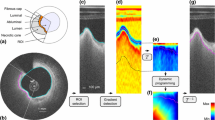Abstract
Acute coronary syndrome represents a leading cause of death. Events are triggered by rupture of atheromatic plaques, as a result of disruption of the overlying fibrous cap. Pathological studies have shown that cap thickness is a critical component of plaque stability. Therefore, assessment of fibrous cap thickness could be a valuable tool for estimating the risk of future events. To aid preoperative planning and peri-operative decision making, intracoronary optical coherence tomography imaging can provide very detailed information about arterial wall structure. However, manual interpretation of the images is laborious, subject to variability, and therefore not always sufficiently reliable for immediate decision of treatment. We present a novel semi-automatic computerized interventional imaging tool to quantify coronary fibrous cap thickness in optical coherence tomography. The most challenging issue when estimating cap thickness is caused by the diffuse nature of the anatomical abluminal interface to be detected. Our method can successfully extract the fibrous cap contours using a robust dynamic programming framework based on a geometrical a priori. Validated on a dataset of 90 images from 11 patients, our method provided a good agreement for minimum cap thickness with the reference tracings performed by a medical expert (35.7 ±33.3 μm, R=.68) and was similar to inter-observer reproducibility (35.2 ±33.1 μm, R=.66), while being significantly faster and fully reproducible. This tool demonstrated promising performances and could potentially be used for online identification of high risk-plaques.
Access this chapter
Tax calculation will be finalised at checkout
Purchases are for personal use only
Preview
Unable to display preview. Download preview PDF.
Similar content being viewed by others
References
World Health Organisation: Cardiovascular diseases (CVDs). Fact Sheet 317 (March 2013)
Virmani, R., Kolodgie, F.D., Burke, A.P., Farb, A., Schwartz, S.M.: Lessons from sudden coronary death: A comprehensive morphological classification scheme for atherosclerotic lesions. Arterioscler. Thromb. Vasc. Biol. 20(5), 1262–1275 (2000)
Burke, A.P., Farb, A., Malcom, G.T., Liang, Y.H., Smialek, J., Virmani, R.: Coronary risk factors and plaque morphology in men with coronary disease who died suddenly. N. Engl. J. Med. 336, 1276–1282 (1997)
Narula, J., Nakano, M., Virmani, R., et al.: Histopathologic characteristics of atherosclerotic coronary disease and implications of the findings for the invasive and noninvasive detection of vulnerable plaques. J. Am. Coll. Card. 61(10), 1041–1051 (2013)
Brezinski, M.E.: Optical coherence tomography for identifying unstable coronary plaque. Int. J. Cardiol. 107(2), 154–165 (2006)
Kume, T., Akasaka, T., Kawamoto, T., et al.: Measurement of the thickness of the fibrous cap by optical coherence tomography. Am. Heart. J. 152(4), 755e1–755e4 (2006)
Kubo, T., Imanishi, T., Takarada, S., et al.: Assessment of culprit lesion morphology in acute myocardial infarction: Ability of optical coherence tomography compared with intravascular ultrasound and coronary angioscopy. J. Am. Coll. Card. 50(10), 933–939 (2007)
Bezerra, H.G., Costa, M.A., Guagliumi, G., Rollins, A.M., Simon, D.I.: Intracoronary optical coherence tomography: a comprehensive review. J. Am. Coll. Cardiol. Intv. 2(11), 1035–1046 (2009)
Tearney, G.J., Regar, E., Akasaka, T., et al.: Consensus standards for acquisition, measurement, and reporting of intravascular optical coherence tomography studies. J. Am. Coll. Card. 59(12), 1058–1072 (2012)
Xu, C., Schmitt, J.M., Carlier, S.G., Virmani, R.: Characterization of atherosclerosis plaques by measuring both backscattering and attenuation coefficients in optical coherence tomography. J. Biomed. Opt. 3, 34003 (2008)
van Soest, G., Goderie, T., Regar, E., et al.: Atherosclerotic tissue characterization in vivo by optical coherence tomography attenuation imaging. J. Biomed. Opt. 15(1), 011105-1–011105-9 (2010)
Ughi, G.J., Steigerwald, K., Adriaenssens, T., et al.: Automatic characterization of neointimal tissue by intravascular optical coherence tomography. J. Biomed. Opt. 19(2), 021104 (2013)
Wang, Z., Chamie, D., Bezerra, H.G., et al.: Volumetric quantification of fibrous caps using intravascular optical coherence tomography. Biomed. Opt. Express 3(6), 1413–1426 (2012)
Zahnd, G., Orkisz, M., Sérusclat, A., Moulin, P., Vray, D.: Simultaneous extraction of carotid artery intima-media interfaces in ultrasound images: assessment of wall thickness temporal variation during the cardiac cycle. Int. J. CARS (2013) (in press), doi:10.1007/s11548-013-0945-0
Dietenbeck, T., Alessandrini, M., Friboulet, D., Bernard, O.: CREASEG: a free software for the evaluation of image segmentation algorithms based on level-set. In: IEEE ICIP, pp. 665–668 (2010)
Caselles, V., Kimmel, R., Sapiro, G.: Geodesic active contours. Int. J. Comput. Vis. 22(1), 61–79 (1997)
Cohen, L.: Minimal paths and fast marching methods for image analysis. In: Paragios, N., Chen, Y., Faugeras, O. (eds.) Handbook of Mathematical Models in Computer Vision, pp. 97–111. Springer, US (2006)
Stone, G.W., Maehara, A., Lansky, A.J.: A prospective natural-history study of coronary atherosclerosis. N. Engl. J. Med. 364(3), 226–235 (2011)
Toutouzas, K., Karanasos, A., Tsiamis, E., et al.: New insights by optical coherence tomography into the differences and similarities of culprit ruptured plaque morphology in non–ST-elevation myocardial infarction and ST-elevation myocardial infarction. Am. Heart J. 161(6), 1192–1199 (2011)
Yonetsu, T., Kakuta, T., Lee, T., et al.: In vivo critical fibrous cap thickness for rupture-prone coronary plaques assessed by optical coherence tomography. Eur. Heart J. 32(10), 1251–1259 (2011)
Author information
Authors and Affiliations
Editor information
Editors and Affiliations
Rights and permissions
Copyright information
© 2014 Springer International Publishing Switzerland
About this paper
Cite this paper
Zahnd, G. et al. (2014). Semi-automated Quantification of Fibrous Cap Thickness in Intracoronary Optical Coherence Tomography. In: Stoyanov, D., Collins, D.L., Sakuma, I., Abolmaesumi, P., Jannin, P. (eds) Information Processing in Computer-Assisted Interventions. IPCAI 2014. Lecture Notes in Computer Science, vol 8498. Springer, Cham. https://doi.org/10.1007/978-3-319-07521-1_9
Download citation
DOI: https://doi.org/10.1007/978-3-319-07521-1_9
Publisher Name: Springer, Cham
Print ISBN: 978-3-319-07520-4
Online ISBN: 978-3-319-07521-1
eBook Packages: Computer ScienceComputer Science (R0)




